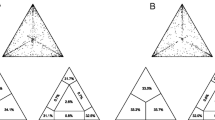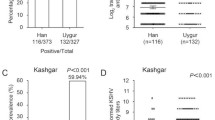Abstract
Because of the abundance of the classical form of Kaposi sarcoma (CKS) among Jews and people of Mediterranean origin, studies have been conducted to find an association between CKS and HLA antigens. No conclusive results have been drawn, although in a number of these investigations an increased incidence of HLA-DR5 was reported. In our study 49 CKS patients of Jewish origin were serologically analyzed for HLA class I and class II antigens. We found no significant deviation in serologically defined HLA antigens frequencies between patients and 99 ethnically matched controls. However, a nonsignificant decrease in the frequencies of HLA-DR4, HLA-DR12, and the combination of DR4/DR11 was observed. Then we determined in these patients HLA-DRB1, HLADQA1, and DQB1 allelic polymorphism by oligotyping on PCR-amplified DNA. In this molecular analysis the only notable finding was a decreased frequency of the combination HLA-DQA1*0301/DQB1*0301, which appeared in one (2%) patient compared to 13 (13%) of the controls. However, the decrease was not statistically significant. On the basis of both serological and molecular analysis done on a relatively large group of CKS patients, we conclude that there is no significant linkage between HLA antigens and CKS in Jewish population.
Similar content being viewed by others
References
Dalgleish AD: Kaposi's sarcoma. Br J Cancer 64:3–6, 1991
Armes J: A review of Kaposi's sarcoma. Adv Cancer Res 53:73–87, 1989
Tappero JW, Conant MA, Wolfe ST, Berger TG: Kaposi's sarcoma. J Am Acad Dermatol 28:371–395, 1993
Huang YQ, Li JI, Rush MG: HPV-16 related DNA sequences in Kaposi's sarcoma. Lancet 339:515–518, 1992
Contu L, Cerimele D, Pintus A, Cottoni F, La Nasa G: HLA and Kaposi's sarcoma in Sardinia. Tissue Antigens 23:240–245, 1984
Cerimele D, Contu L, Scappaticci S, Cottoni F: Kaposi's sarcoma in Sardinia: An epidemiologic and genetic investigation. Ann NY Acad Sci 437:216–227, 1984
Papasteriades C, Kaloterakis A, Filiotou A,et al.: Histocompatibility antigens HLA-A, -B, -DR in Greek patients with Kaposi's sarcoma. Tissue Antigens 24:313–315, 1984
Pollack MS, Safai B, Myskowsky PL, Gold JWM, Pandey J, Dupont B: Frequencies of HLA and Gm immunogenetic markers in Kaposi's sarcoma. Tissue Antigens 21:1–8, 1983
Marinig C, Fiorini G, Boneschi V, Melotti E, Brambilla L: Immunologic and immunogenetic features of primary Kaposi's sarcoma. Cancer 55:1899–1901, 1985
Tzfoni EE, Scherman L, Battat S, Brautbar H: No HLA antigen is significant in classic Kaposi's sarcoma. J Am Acad Dermatol 28:118–119, 1993
Johns MB Jr, Paulus-Thomas JE: Purification of human genomic DNA from whole blood using Sodium Perchlorate instead of Phenol. Anal Biochem 180:276–278, 1989
Tsuji K, Aizawa M, Sasazuki T (eds): HLA 1991—Proceedings of 11th International Histocompatibility Workshop and Conference. Oxford, Oxford University Press, 1992
Zetterquist H, Olerup O: Identification of the HLA-DRB1*04, DRB1*07, and DRB1*09 alleles by PCR amplification with sequence-specific primers (PCR-SSP) in 2 hours. Hum Immunol 34:64–74, 1992
Morel C, Zwahlen F, Jeannet M, Mach B, Tiercy JM: Complete analysis of HLA DQB1 polymorphism and DR-DQ linkage disequilibrium by oligonucleotide typing. Hum Immunol 29:64–77, 1990
Nepom GT, Erlich H: MHC class II molecules and autoimmunity. Annu Rev Immunol 9:493–525, 1991
Brenner S, Krakowsky A, Schewach-Millet M, Ronen M, Orgad S, Gazit E: Increased frequency of HLA-Awl9 in Kaposi's sarcoma. Tissue Antigens 19:392–394, 1982
Reinharz D, Tiercy JM, Mach B, Jeannet M: Absence of DRw15/3 and of DRw15/7 heterozygotes in Caucasian patients with systemic lupus erythematosus. Tissue Antigens 37:10–15, 1991
Thorsby E, Ronningen KS: Particular HLA-DQ molecules play a dominant role in determining susceptibility or resistance to Type-1 (insulin dependent) diabetes mellitus. Diabetologia 36:371–377, 1993
Charron D: Molecular basis of human leukocyte antigen class II disease associations. Adv Immunol 48:107–159, 1990
Bell JI, Todd JA, McDevitt HO: The molecular basis of HLA-disease association. Adv Hum Genet 18:1–41, 1989
Cerimele D, Contu L, Carcassi C,et al.: HLA and multiple skin carcinomas. Dermatologica 176:176–181, 1988
Myskowsky PL, Pollack MS, Schorr E, Dupont B, Safai B: Human leukocyte antigen associations in basal cell carcinoma. J Am Acad Dermatol 12:997–1000, 1985
Czarnecki D, Lewis A, Nicholson I, Tait B: Multiple basal cell carcinomas and HLA frequencies in southern Australia. J Am Acad Dermatol 24:559–561, 1991
Author information
Authors and Affiliations
Rights and permissions
About this article
Cite this article
Strichman-Almashanu, L., Weltfriend, S., Gideoni, O. et al. No significant association between HLA antigens and classic kaposi sarcoma: Molecular analysis of 49 jewish patients. J Clin Immunol 15, 205–209 (1995). https://doi.org/10.1007/BF01541091
Accepted:
Issue Date:
DOI: https://doi.org/10.1007/BF01541091




